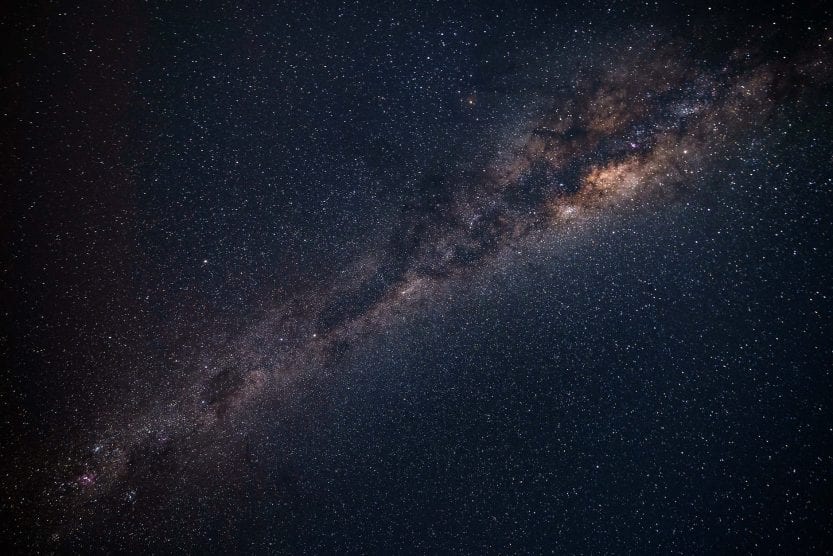A blue giant is among the hottest, most luminous and massive stars. They appear blue in color as the tremendous amounts of energy they release as they burn produce light in the blue end of the spectrum. A hot luminous star expands as its core hydrogen is exhausted. It first turns into a blue sub giant and then a blue giant as it gets cooler and more luminous. Intermediate mass stars will expand until they become red giants. Blue super giants are formed from the more massive stars and these are even more luminous and hotter. The term blue giant does not have a clear definition in astronomy. It is often used for any big and hot star that produces blue light and can apply to stars in different stages of their evolution.
- Blue giant stars occupy a position above and to the right of the main sequence of stars in the Hertzsprung – Russell (HR) diagram. The term includes stars in different stages of development, which have moved away from the main sequence.

- Blue giants produce way more energy than our Sun which is a yellow dwarf. For comparison, the Sun has a surface temperature of around 6000 K whereas that of a blue giant is over 10000 K. Blue giants are even hotter with surface temperatures of 20000 – 50000 K and can be many times larger than the Sun. For instance, Rigel which is a blue supergiant in the Orion constellation burns at a temperature of 11000 K and is about 25 times the size of the Sun.

- Rigel is considered the seventh brightest star in the sky. It is also the largest star in any multiple star system. It is designated as the Alpha of Orion the Hunter. It is of significance to the history of star observation and has a place in Norse mythology. (The story goes that as the Valiant Aurwandill was travelling with the god Thor, his big toe froze as they tried to cross a river. Thor broke off the frozen digit and threw it up into the heavens and it turned into the star we now see as Rigel.
- Due to the tremendous amounts of energy produced, these stars have luminosities that can reach more than a million times that of the Sun.
- The heaviest blue supergiant is 315 times as massive as the Sun. This star is found in the Large Megallanic Cloud and is designated as R135a1. With a surface temperature of 53000 K, it shines at 8.7 million solar luminosities. It is the most massive star ever to be discovered.
- Blue giants are relatively rare to be seen although they mark their presence with their brightness. Astronomers have till date identified only about 20 blue giant stars and very few of them are found in the Milky Way galaxy. Spica is a binary star system. One of its members is a blue giant is of historical importance. It was the observation of its movement through the sky that led the ancient Greek astronomer Hipparchus to describe the precession of equinoxes. The blue giant member of Spica is also the 4th brightest star in the constellation of Virgo.
- Blue giants have short lives. A star survives by the fusion of hydrogen into helium. Stars with larger masses burn their hydrogen supply faster and thus have shorter lifespans. So blue giants live only a fraction of the life of our Sun. As blue giants use up their hydrogen, their core temperatures rise. This leads to the fusion of helium nuclei to form carbon, oxygen and so on. However this does not go on forever. When enough iron is formed on the surface, it collapses with a violent explosion called a supernova. It tears the star apart leaving a rapidly spinning core behind. This is called a pulsar and pulsars are tiny with a diameter of only around 40 km.
- Blue super giants die even faster. Rigel, for example is losing its mass at a speed of 10 million times that of our Sun. They collapse through the pulsar stage as well. However their gravity is so intense that their cores are crushed down into an infinitely tiny point known as a singularity. Since the escape velocity from this singularity is more than that of the speed of light, it is called a black hole. A black hole is a region of infinitely warped space time.

- Blue giants do not have planets. One of the reasons for this is that planets take billions of years to form. The short lifespans of blue giants normally do not allow this.
- Most blue giants have very strong solar winds. Few of them even have dusty discs orbiting them. The solar winds are another barrier against the formation of planets.
- Massive convective currents ferry hot material from the core and cool stuff from the surface of stars. In blue giant stars the convection is more turbulent and unstable. The outer layers of material get detached slightly from the star and then cool down. The cooled chunk of star material is ejected from the surface by the radiation and appears as a massive burst of light.
- With modern space telescopes, astronomers can listen to the sounds generated by stars. By the analysis of these sounds it is possible to study the nature of the interior of these stars. And by such studies, we know that the blue super giant stars produce all the chemical elements beyond helium in Mendeleev’s Periodic Table. Thus the blue super giants are colossal metal factories of our universe.
- There is a limit to the luminosity of a star called the Eddington Limit. Such a limit exists because of the force of gravity that pulls matter inward. Blue supergiant stars live close to this limit. Sometimes their radiation exceeds this limit and the star brightens up by ejecting matter outwards. Balance returns when the star has lost enough matter to have it drop back below the Eddington Limit. A classic example of this is Eta Carinae which became the second brightest star in the sky for 3 days in 1843. This happened as an aftermath of an event now known as the Great Eruption.
- Blue giants are classified into the O spectral class. Most of them are found in OB stellar associations. These are little groups of massive hot stars which must have all originated from the same molecular cloud at about the same time. As the fully formed stars blow the left over gas and dust away, the O and B stars start to drift away from each other. These associations also contain other types of stars.
- Some blue giant stars spin at extremely high velocities. An example of this is VFTS 102 which is a blue super giant in the Large Megallanic Cloud known as the Tarantula Nebula. It rotates at a speed of 600 km/sec at its equator. (For perspective, this is almost a hundred times faster than the rotational velocity of the Sun). This causes the star to fling material out to form a disc made of stellar material surrounding it. The reasons for such activity are unknown although it is speculated that the accretion of material from a nearby star could spin it up.
- Blue giants can be observed in the constellation of Orion. They can also be easily spotted in open star clusters. Open star clusters are groups of hot, young, blue – white stars which have not yet drifted away from each other. A famous example is the Pleiades, which can be seen from the Northern Hemisphere. Another famous open cluster is the Jewel Box cluster in the Crux constellation. It contains a number of blue giant stars too.
- The coolest and least luminous among the blue giants are placed on the horizontal branch of the HR diagram. These are intermediate mass stars which have been through the stage of a red giant and are currently burning Helium in the core. As they burn more helium, they gradually move blue wards until all the helium is exhausted. Then they come back in a red ward direction on the HR diagram to the asymptotic giant branch.
- The hottest blue giants found on the horizontal branch of the HR diagram are called extreme horizontal branch (EHB) stars. These typically burn at temperatures above 25000 K. As they burn out their helium, they lose most of the outer envelope. This brings out the blue colored core of the star. These EHB stars are considered to be the sources of faint ultra violet glows observed from certain galaxies.
Many blue giants and super giants have been born and dead in the course of life on Earth. Many blue giants our ancestors saw are no more in the sky and the ones we see may not be there for our progeny to look at. Though short lived and rare, they definitely are among the most brilliant and magnificent celestial objects visible to us.




